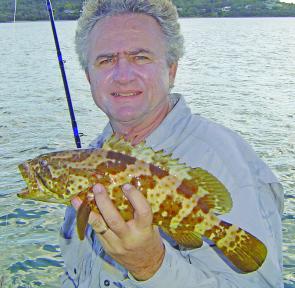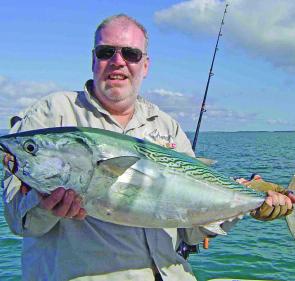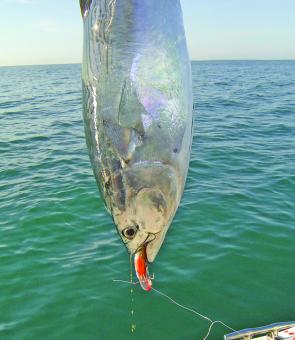What’s with this wind? We were buffeted by wind even during the Christmas and New Year period which is normally a great time to be on the water in Gladstone. In February, I would expect that conditions would improve. After all, the majority of us will be back at work!
There is a lot happening in the estuaries, as they seem to be the only place to fish safely. Trees Inlet is very popular at the moment and you can share the rock walls near the conveyor bridge with half a dozen or more boating anglers. There is plenty of room here and with the Lillies campground less than 400m away it is a perfect spot for little tinnies to come and go.
I prefer to flick prawns towards the rock walls near the conveyor belt bridge and always come away with a good feed of black and silver bream and grunter. Further along I like to park the boat in any one of the several mangrove drains that flood into or from the main creek. I much prefer a falling tide where I work on the assumption that any fish that were in there would have to come out.
I have hooked up to plenty of bream, grunter and Moses perch from these drains and small prawns and squid are the bait of choice. If the fish are picky, I use small peeled prawns – even small pieces of peeled prawns.
There are plenty of fishers on foot hooking up to some very respectable bream in Auckland Creek. The highways bridges are worth a flick and if you can get in close to the pylons you might pick up a cod or two.
Some good specimens have been caught at Manning Reef. These include parrot and a few trevally. Sea bream can also be caught here. This is a popular spot to grab hold of some small black tipped reef sharks. I prefer to fish here on the small tides when there is just enough movement in the water to keep the fish active but not enough to cause problems keeping the boat straight.
The warmer weather has brought surface action to the harbour with baitfish boiling on the surface, especially when menaced by pelagic species like tuna or mackerel. The trick when seeing this surface action is to try and read the direction of the baitfish – and that is not easy.
Bringing the boat too close to the action and/or making too much noise will see the surface bait and your target fish dive deep and scatter. Then all bets are off. The trick is to circle the surface melee slowly and quietly, hurl lures into the middle of the action and then wind like crazy. Hook-ups are usually instantaneous although not always.
On a recent trip Al and I travelled into the harbour around Gatcombe Head, on the southern end of Facing Island. We worked the edge of the main shipping channel where the depth dropped from nearly 20m to about 100m. There is not a whole lot of structure so we drifted and as luck would have it we drifted along the edge of the drop off.
We were plonking squid to the bottom – Al with his customary 50cm heavy trace to swivel and sinker and me with my favoured paternoster rig.
Al was picking up some half decent cod and a couple of smallish grassy sweetlip. I was picking up some very small cod and the occasional small redthroat. Our attention was soon caught by some intensive surface action about 500m away. Fish were breaking the surface and birds were swooping into the fray.
We kept our eye on the fracas but we were set up for bottom bashing and didn’t have any gear ready for casting into a mass of baitfish so we lazily kept fishing the bottom with moderate success.
However that soon changed when the mass of fishing action changed direction and started heading our way. I dived for my lure box, cut off my paternoster rig and quickly tied on a metal slug with what could only be called the dodgiest ever trebles. I know maintenance is next to godliness, but I was sure they weren’t THAT rusty when I put them away.
The slug was tied directly to the line. I didn’t even have time to put a leader or any form of heavier trace on to the main line.
Anyway, rusty trebles or not, it was all I had. I moved the boat and began to slowly circle close to this piscatorial mass. So as not to scare the fish, I killed the motor when we were within hurling distance and allowed the boat to drop to a halt. While I was at the controls, Al threw my slug right into the middle of the fray. One crank of the handle and the line was being stripped from the reel and fast.
For the next ten minutes or so we battled this speedster. One moment we would get back line and within seconds we would lose twice as much. The reel was a virgin Christmas gift – a Mitchell Orca 80S spinning reel loaded with 10kg mono line and it was performing very well indeed. The drag was set enough to allow the fish to fight but it had to work hard to do so.
The battle ensued and in typical mack tuna fashion, the fish came to the boat on the surface completely exhausted. We were waiting for the last burst of energy but it didn’t come. Like me, it was buggered.
Al was on the gaff when we saw the slug and the dodgy old treble hanging precariously by one hook just above the pectoral fins. We had jagged the fish and the lure was just hanging on!
Al gaffed the fish and one quality mack tuna was on ice and one metal slug with dodgy trebles was put in the “Repair Later” box. Luck was with on our side that day.
Winding lures or slugs quickly through a mass of fish certainly is a consistent hook up technique when fishing for pelagics, but on a previous trip a different technique got the hook-up.
Just off Curtis Island, Paul and I encountered a similar boiling water incident and we madly hurled lures into the school of fish that we thought were mackerel. We were winding like windmills for what seemed like several hours but would have only been a few minutes. The fish had gone off the boil and the mass of baitfish had disappeared.
Our muscles were burning so we gave up, stopped and looked at each other in desperation and defeat. Just as we started winding in our lures at a more sedate speed, Paul’s rod went ballistic and a mack tuna sped off stripping his share of line in the process. Luckily the drag was set correctly.
This one came to the boat with a lure and good quality trebles stuck firmly in his gob. And that is a good lesson to all of us – it’s not all over until the fat tuna sings, or words to that affect!
I did learn a little trick when cooking tuna. After filleting the tuna, soak the fillets in brine for a few hours. Discard the water as it draws all the blood from the meat and will be pink. Just prior to cooking, blanch the fillets in boiling water for a few seconds. Then drop the fillets onto a really hot barbecue plate for a few minutes only. Tuna is delicious slightly undercooked but awful if cooked until it is dried out.
Reads: 1341
Little cod were hitting our bait while drifting along the drop-off near Gatcombe Heads.

The mack tuna caught in the harbour near Gatcombe proved that good angling is more important than good gear!

One mack tuna caught unexpectedly on a very slow retrieve.




